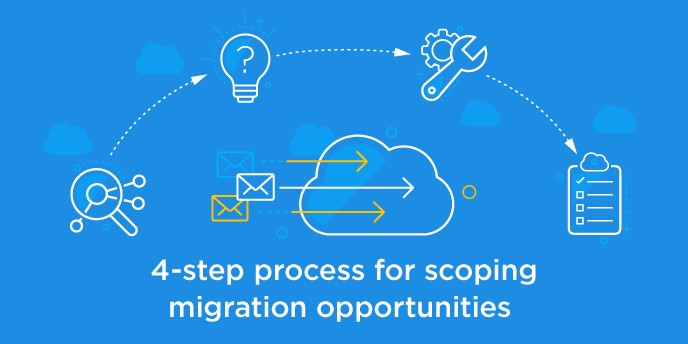A how-to for MSPs to effectively scope an email migration
In this first blog post in our migration sales success series we explore best practices and resources for scoping an Office 365 email migration project.
Why it’s important to right size the migration opportunity
The success of any migration project is dependent on accurate scoping and planning – and is key to reducing uncertainties for both customer and IT partner. Without an accurate estimate of all the factors that could impact the project, the Statement of Work (SOW) is subject to scope creep and financial risk for the partner – not to mention a poor experience for the customer. The most successful partners make scoping each project an integral part of their pre-sales customer engagement.
Many MSPs find that with all the variables involved in performing an email migration to Office 365, project delays and increased sales costs are not uncommon- especially when having to manually estimate opportunities. That’s why it’s critical for MSPs to adopt an approach to scoping that is the right balance of accuracy and agility – leveraging automation and standardized templates and approaches where applicable. To help find this balance, we’ve pulled together several resources and best practices that will allow MSPs to scope migration opportunities in 4 simple steps.

Step 1: Get a comprehensive view of customers‘ source environment
Many MSPs begin the scoping process by gaining insight into their customer’s email environment. Since many customers do not have a comprehensive inventory of their current email, an interview with the customer is typically not sufficient. For example, there could be mailboxes the customer is not aware of, say old mailboxes from former employees. Knowing if these mailboxes contain critical data and need to be migrated, or if they are of no importance, impacts the cost of the migration and ultimately customer satisfaction – no one wants to be charged for unnecessary work. The discovery process helps set the stage for planning purposes, as you’ll have an actionable list of information about the source environment -which you can use with the customer to help architect both the migration and their new environment. From helping the customer determine the number of Office 365 licenses required, to identifying the email protocol and DNS information, a comprehensive discovery is key to mitigating risks, overcoming challenges and ensuring customer satisfaction.
To help Partners accomplish this essential step, SkyKick provides free use of its Migration Discovery Services. With just a single username and password of any active mailbox, the Migration Discovery Services examines the source server to ascertain the highest fidelity protocol for the migration and automates the discovery of the source email environment; including mailboxes, distribution groups (and their members), aliases, and public folders. Many Partners find this automated approach helps them save time while simultaneously getting a comprehensive view into the customer’s environment.
“This discovery before the SOW not only avoided scope creep, it gave me the opportunity to provide valuable consultation with the customer as to how to address the mail in these mailboxes.”
– Jade H., SkyKick Partner Development Director and previous IT Partner. Learn more

Step 2: Ask the right questions
In addition to acquiring details about the customer’s source environment there are core and supplemental considerations you’ll need to explore. Many MSPs create checklists to ensure they understand key items that could impact the migration project and help set proper customer expectations and engagement protocols – which leads to a more accurate SOW.
In collaboration with several of our top performing partners, SkyKick created a Migration Pre-Order Checklist to help partners prepare, plan, and price for each migration project. Included in this checklist are the following areas and examples:
Core Migration Scoping
– Number of domains
– Customer bandwidth
– Spam filters
Supplemental Migration Scoping
– Printers or other non-PC devices that send/receive email
– 3rd Party hardware/software that may interfere with the migration
Customer Requirements
– Roles and resources
– Access requirements
– Information and collaboration requirements
„Because of all the complexities of a migration – our partners were looking for a standardized way to capture the most important elements during their discovery or pre-sales calls so they could easily address them and effectively set expectations with their customers. This checklist was created based on learnings from thousands of diverse migrations and is now being used by partners of all sizes to streamline internal processes and maximize revenue.“
– Joana Rocha, SkyKick Technical Solution Specialist

Step 3: Determine complexity and manual effort
There are a variety of factors that can impact the complexity and/or manual effort required for a successful email migration. To account for every single one can be unnecessarily time-consuming, but to miss an important one can be costly. To help partners quickly estimate the technical resources required for a project, while ensuring the most impactful elements are covered, we created Key Complexity Factors for Email Migration Project Scoping.

Step 4: Create the migration plan
In this final step, we recommend using SkyKick’s Migration Planner side-by-side (or in a screen-share) with your customer to finalize what will be included in the project and to show how various tasks will be performed (e.g. source access method, Outlook Assistant deployment method, DNS actions, email configuration, etc.). It’s a great opportunity to walk through the process and key configuration options so you can set expectations and ensure their questions are answered before providing a more in-depth SOW.
Of course, registered partners can use SkyKick’s Migration Planner for free. Register here.
Like what you’ve read?
If you liked this article then check back for our next blog, where we’ll share how to create, review and finalize a statement of work for your next migration project – which uses much of the information collected during the scoping phase.


